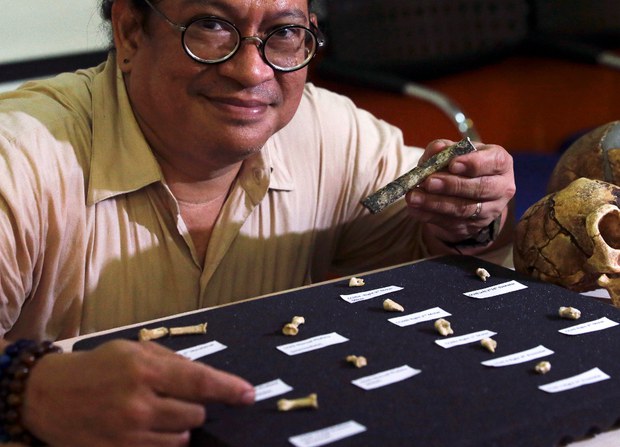Scientists Discover a New Human Species in Northern Philippines
2019.04.11
Manila
 Filipino archeologist Armand Salvador Mijares shows bones and teeth belonging to a new species called Homo luzonensis during a press conference in Manila, April 11, 2019.
Filipino archeologist Armand Salvador Mijares shows bones and teeth belonging to a new species called Homo luzonensis during a press conference in Manila, April 11, 2019.
Filipino-led scientists have discovered remains of a new human species that is believed to have lived tens of thousands of years ago in the northern Philippines, researchers announced Thursday.
The skeletal remains were dubbed Homo luzonensis after the Philippines’ main Luzon island where they were found, said Armand Mijares, an archaeologist who teaches at the University of the Philippines and served as team leader of the scientists.
He said the bones were unearthed in Peñablanca town in Cagayan province by scientist and researchers from France, Australia and the Philippines and from Callao cave on Luzon island.
Excavation crew members in 2007 discovered a toe bone from the floor of the limestone cavern of Callao Cave. The deeper they dug, the more they discovered, Mijares said.
“There’s something peculiar with this bone, (and we were) thinking it’s not a modern human bone. So we kept digging for four years. And in 2011, dug more toe bones, as well as finger bones, part of a thigh bone and seven teeth,” he said.
“Based on our studies, the species lived at least 50,000 to 67,000 years ago,” Mijares said.
Professor Philip Piper from The Australian National University (ANU) and another lead member of the team, said the findings represent a major breakthrough in understanding human evolution across Southeast Asia. Piper said researchers uncovered the remains of at least two adults and one juvenile.
“The fossil remains included adult finger and toe bones, as well as teeth. We also recovered a child’s femur. There are some really interesting features – for example, the teeth are really small,” Piper said in a publication by the ANU, adding the samples were retrieved in 2007, 2011 and 2015.
“The size of the teeth generally, though not always, reflect the overall body size of a mammal, so we think Homo luzonensis was probably relatively small. Exactly how small, we don’t know yet. We would need to find some skeletal elements from which we could measure body size more precisely,” he said.
Piper said the bones were similar to a species consider the early ancestor of humans dating back to 2 million years ago. Recent excavations near Callao cave produced evidence of a butchered rhinoceros and stone tools dating to around 700,000 years ago.
The specimens also share unique skeletal features with the famous Homo floresiensis or “the hobbit,” discovered in 2003 on the Indonesian island of Flores, southeast of the Philippine archipelago. The Flores remains date to between 60,000 and 100,000 years ago, according to the Smithsonian Institution.







